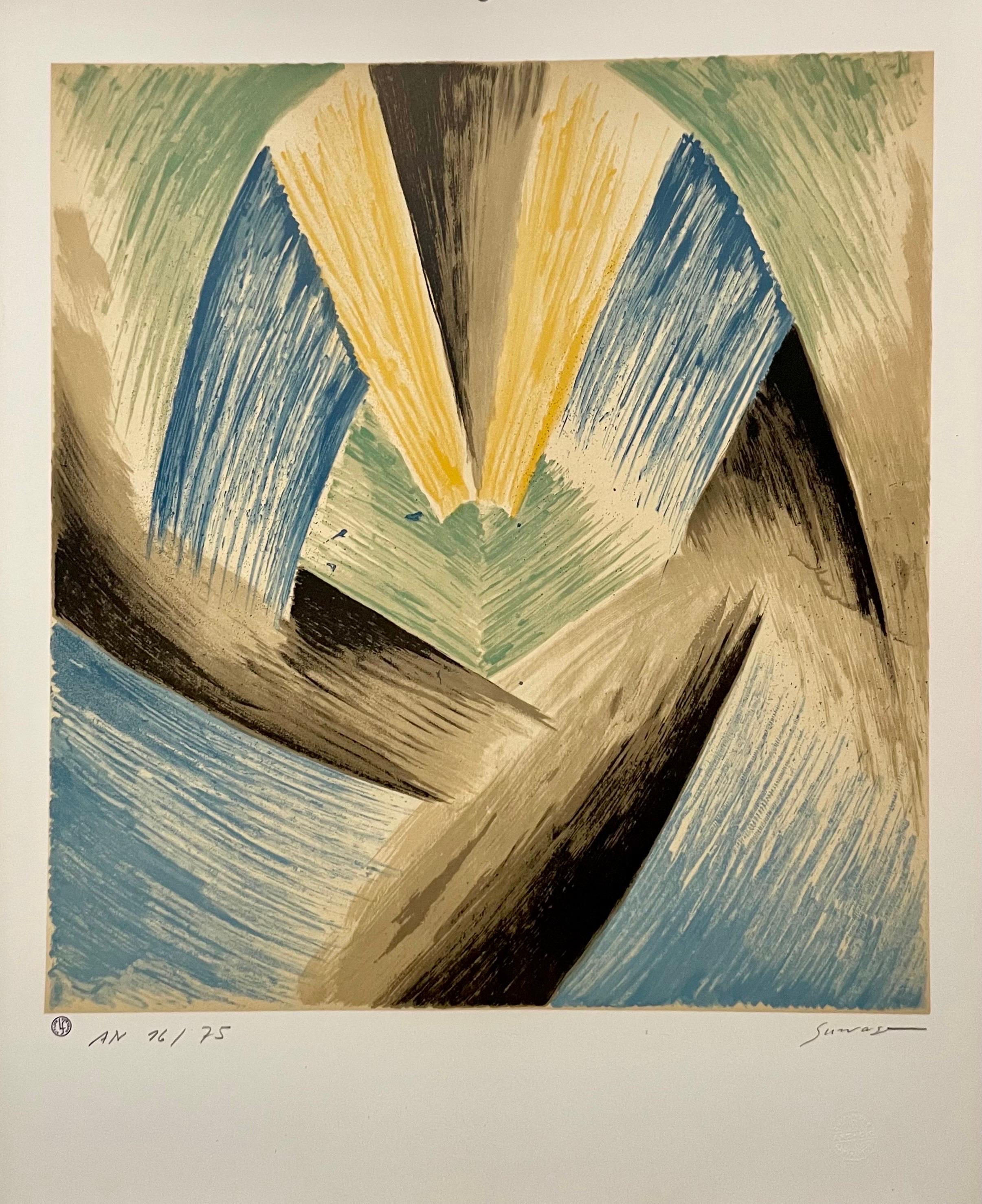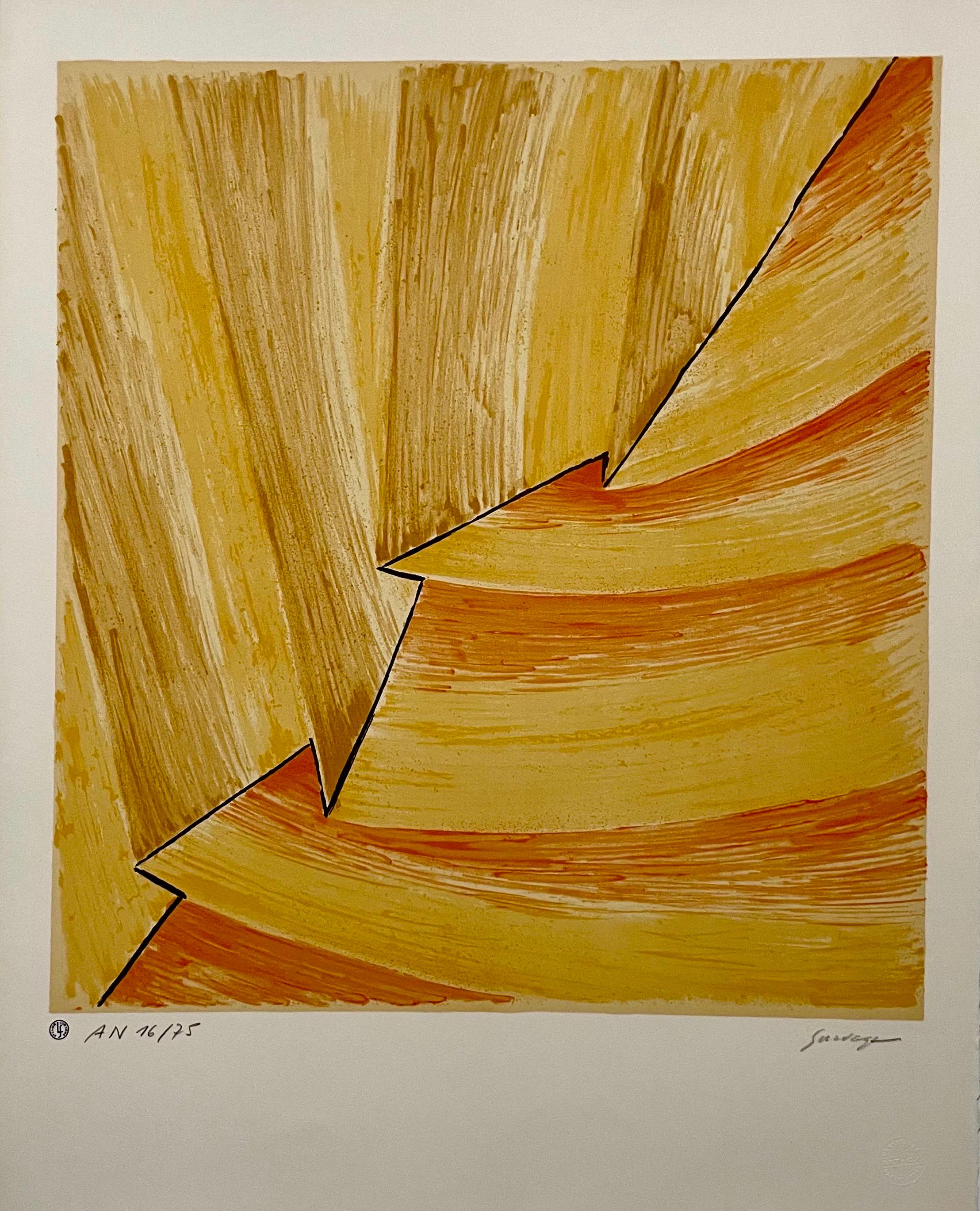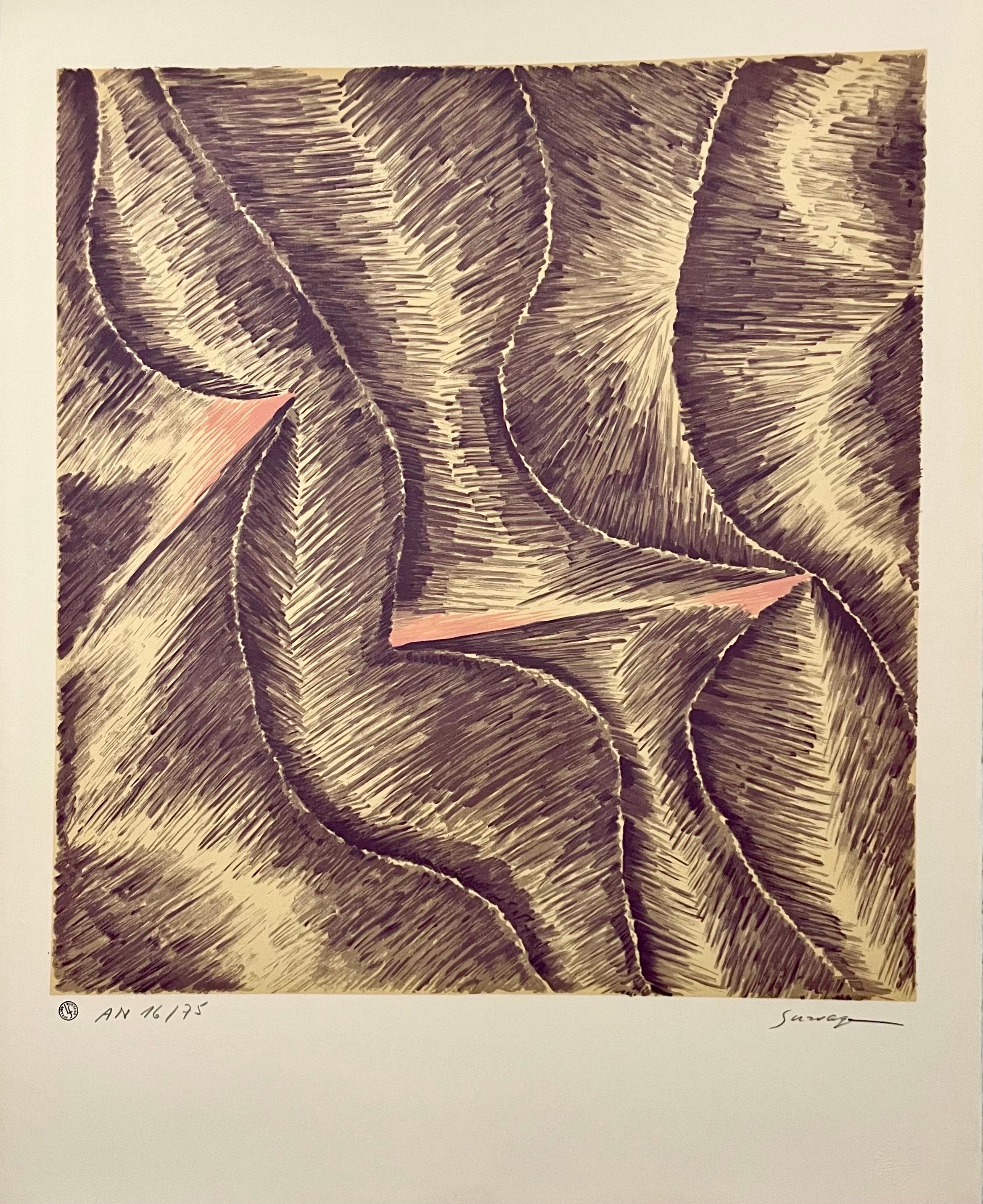Léopold SurvageRussian French Avant Garde Lithograph Rhythm in Colour Vibrant Abstract Print1967-1968
1967-1968
About the Item
- Creator:Léopold Survage (1879-1968)
- Creation Year:1967-1968
- Dimensions:Height: 25.5 in (64.77 cm)Width: 20.13 in (51.14 cm)
- Medium:
- Movement & Style:
- Period:
- Condition:good. this has never been framed.
- Gallery Location:Surfside, FL
- Reference Number:1stDibs: LU3829982762
Léopold Survage
At a young age, Léopold Survage was directed to enter the piano factory operated by his Finnish father. He learned to play piano and then completed a commercial diploma in 1897. After a severe illness at the age of 22, Survage rethought his career and entered the Moscow School of Painting, Sculpture and Architecture. Introduced to the modern movement through the collections of Sergei Shchukin and Ivan Morozov, he cast his lot with the Russian avant-garde and, by 1906, was loosely affiliated with the circle of the magazine Zolotoye runo. He met Alexander Archipenko, exhibiting with him in the company of David Burlyuk, Vladimir Burlyuk, Mikhail Larionov and Natalia Goncharova.
With Hélène Moniuschko, later his wife, he traveled to Western Europe, visiting Paris in July 1908. The couple eventually settled in Paris where Survage worked as a piano tuner and briefly attended the short-lived school run by Henri Matisse. He exhibited with the Jack of Diamonds group in Moscow in 1910 and first showed his work in France at the urging of Archipenko in the Salon d'Automne of 1911. In 1913, Survage produced abstract compositions using color and movement to evoke a type of musical sensation. Entitled Rythmes colorés, he planned to animate these illustrations using film to form "symphonies en couleur". He saw these abstract images as flowing together, but he exhibited the ink wash drawings separately at the Salon d'Automne in 1913 and Salon des Indépendants in 1914. Articles on these works were published by Guillaume Apollinaire (Paris-J., July 1914) and Survage himself (Soirées Paris, July–August 1914).
In June 1914, to develop his idea, Survage unsuccessfully applied for a patent to the Gaumont Film Company. Had he been able to raise the funds, he would have preceded Viking Eggeling and Hans Richter as the first to develop abstract films. Beginning in 1917, Survage shared a studio and a penchant for alcoholic excesses with Amedeo Modigliani in Paris. Survage later moved to Nice and, over the next eight years, produced highly structured oils and works on paper linked together by a series of leitmotifs, repeating groups of symbolic elements—man, sea, building, flower, window, curtain, bird as if they were protagonists in a series of moving images. The influence may have been Marc Chagall's, an artist well known for his insertions of floating couples, cows, roosters, and sundry Jewish iconography. By 1922, Survage had begun to move away from Cubism in favor of the neo-classical form. He was perhaps influenced by commissions for Serge Diaghilev's Ballets Russes, beginning with sets and costumes for Igor Stravinsky's opera buffa Mavra at the Paris Opéra in 1922. Although mainly a painter, he also produced stage, tapestry, and textile designs during this period (notably for the house of Chanel in 1933). Toward the end of the 1930s, as a result of his contact with André Masson, Survage became increasingly charmed by symbols and mysticism. The curvilinear forms that had previously dominated his compositions came, once again, under the control of the geometric structure. Survage was inducted into France's Légion d'Honneur in 1963. He died on 31 October 1968 in Paris.
- ShippingRetrieving quote...Ships From: Surfside, FL
- Return PolicyA return for this item may be initiated within 3 days of delivery.
- Russian French Avant Garde Lithograph Rhythm in Colour Vibrant Abstract PrintBy Léopold SurvageLocated in Surfside, FLLéopold Survage (French/Russian, 1879-1968), "Rythmes Colorés", 1967-1968 Lithograph on Vélin d'Arches paper, Printed by Mourlot, Paris Hand signed in pencil and numbered "AN 16/75"...Category
1960s Cubist Abstract Prints
MaterialsLithograph
- Russian French Avant Garde Lithograph Rhythm in Colour Vibrant Abstract PrintBy Léopold SurvageLocated in Surfside, FLLéopold Survage (French/Russian, 1879-1968), "Rythmes Colorés", 1967-1968 Lithograph on Vélin d'Arches paper, Printed by Mourlot, Paris Hand signed in pencil and numbered "AN 16/75"...Category
1960s Cubist Abstract Prints
MaterialsLithograph
- Russian French Avant Garde Lithograph Rhythm in Colour Vibrant Abstract PrintBy Léopold SurvageLocated in Surfside, FLLéopold Survage (French/Russian, 1879-1968), "Rythmes Colorés", 1967-1968 Lithograph on Vélin d'Arches paper, Printed by Mourlot, Paris Hand signed in pencil and numbered "AN 16/75"...Category
1960s Cubist Abstract Prints
MaterialsLithograph
- American Modernist Cubist Lithograph Screenprint "Reclining Woman" Max WeberBy Max WeberLocated in Surfside, FLReclining Cubist Nude Woman Max Weber (April 18, 1881 – October 4, 1961) was a Jewish-American painter and one of the first American Cubist painters who, in later life, turned to more figurative Jewish themes in his art. He is best known today for Chinese Restaurant (1915), in the collection of the Whitney Museum of American Art, "the finest canvas of his Cubist phase," in the words of art historian Avis Berman. Born in the Polish city of Białystok, then part of the Russian Empire, Weber emigrated to the United States and settled in Brooklyn with his Orthodox Jewish parents at the age of ten. He studied art at the Pratt Institute in Brooklyn under Arthur Wesley Dow. Dow was a fortunate early influence on Weber as he was an "enlightened and vital teacher" in a time of conservative art instruction, a man who was interested in new approaches to creating art. Dow had met Paul Gauguin in Pont-Aven, was a devoted student of Japanese art, and defended the advanced modernist painting and sculpture he saw at the Armory Show in New York in 1913. In 1905, after teaching in Virginia and Minnesota, Weber had saved enough money to travel to Europe, where he studied at the Académie Julian in Paris and acquainted himself with the work of such modernists as Henri Rousseau (who became a good friend), Henri Matisse, Pablo Picasso, and other members of the School of Paris. His friends among fellow Americans included some equally adventurous young painters, such as Abraham Walkowitz, H. Lyman Sayen, and Patrick Henry Bruce. Avant-garde France in the years immediately before World War I was fertile and welcoming territory for Weber, then in his early twenties. He arrived in Paris in time to see a major Cézanne exhibition, meet the poet Guillaume Apollinaire, frequent Gertrude Stein's salon, and enroll in classes in Matisse's private "Academie." Rousseau gave him some of his works; others, Weber purchased. He was responsible for Rousseau's first exhibition in the United States. In 1909 he returned to New York and helped to introduce Cubism to America. He is now considered one of the most significant early American Cubists, but the reception his work received in New York at the time was profoundly discouraging. Critical response to his paintings in a 1911 show at the 291 gallery, run by Alfred Stieglitz, was an occasion for "one of the most merciless critical whippings that any artist has received in America." The reviews were "of an almost hysterical violence." He was attacked for his "brutal, vulgar, and unnecessary art license." Even a critic who usually tried to be sympathetic to new art, James Gibbons Huneker, protested that the artist's clever technique had left viewers with no real picture and made use of the adage, "The operation was successful, but the patient died."[8] As art historian Sam Hunter wrote, "Weber's wistful, tentative Cubism provided the philistine press with their first solid target prior to the Armory Show." The Cellist...Category
Mid-20th Century Cubist Abstract Prints
MaterialsScreen
- Figural Abstract Mid Century Modern Lithograph Portraits, Judaica, Jewish PrintBy Rita GombinskiLocated in Surfside, FLThis is a proof print and is unsigned. it has Jewish Hebraic motifs, a menorah with a Jewish star, a mezusah or megilla scroll by this talented Jewish woman artist. Her whole life lo...Category
Mid-20th Century Cubist Figurative Prints
MaterialsCanvas, Oil
- Monoprint Lithograph American Modernist Gregory Amenoff Abstract ExpressionistBy Gregory AmenoffLocated in Surfside, FLGregory Amenoff (Contemporary American abstract painter, b. 1948), Monotype Monoprint (1990) Hand signed in pencil lower right plate: 16 x 16 inches frame dimensions: 35 1/8 x 29 1/8 x 1 5/8 inches, wood frame with glazing Provenance: Corporate Collection of Bank BNP Paribas Gregory Amenoff is a painter who lives in New York City and Ulster County, New York. He is the recipient of numerous awards from organizations including the American Academy of Arts and Letters, National Endowment for the Arts, New York State Council on the Arts and the Tiffany Foundation. He has had over fifty one-person painting exhibitions in museums and galleries throughout the United States and Europe. His work is in the permanent collections of more than thirty museums, including the Whitney Museum of American Art, the Museum of Fine Arts in Boston, the Museum of Modern Art in New York and the Metropolitan Museum of Art. His work has the influence of both Abstract Expressionism and Pop Art in it, biomorphic forms in rich hues and thick textures with heightened colors and abstracted, organic forms, late American Modernism. He moved to New York in 1979, the artist rose to critical acclaim in the 1980s alongside Terry Winters, Bill Jensen, and Katherine Porter. The artist lives and works between New York, NY and his Hudson Valley residence. He was a collaborating artist illustrating Bradford Morrow, Bestiary along with Joe Andoe, James Brown, Vija Celmins, Louisa Chase, Eric Fischl, Jan Hashey, Michael Hurson, Mel Kendrick, James Nares, Ellen Phelan, Joel Shapiro, Kiki Smith, David Storey, Michelle Stuart, Richard Tuttle, Trevor Winkfield, Robin Winters. Linoleum cuts with pochoir and woodcuts for the Grenfell Press, New York. Amenoff served as President of the National Academy of Design from 2001-2005. He is a founding board member of the CUE Art Foundation in New York City and serves as the CUE Art Foundation's Curator Governor. Amenoff has taught at Columbia for the last eighteen years, where he holds the Eve and Herman Gelman Chair of Visual Arts and is currently the Chair of the Visual Arts Division in the School of the Arts. He is currently the Vice-President of the National Academy. In 2011 he received the John Solomon Guggenheim Fellowship. Museum Collections Albright-Knox Art Gallery; Buffalo, NY Art Institute of Chicago; IL Baltimore Museum of Art; Brooklyn Museum of Art; Brooklyn, NY Butler Institute of American Art; Youngstown, OH Cleveland Museum of Art; Cleveland, OH Currier Gallery of Art; Manchester, NH Frances and Sidney Lewis Foundation; Richmond, VA Hood Museum of Art; Hanover, NH Honolulu Academy of Art; Honolulu, HW Kemper Museum of Contemporary Art; Kansas City, MO Maier Museum of Art; Lynchburg, VA Metropolitan Museum of Art; New York, NY Milwaukee Museum of Art; Milwaukee, WI Minneapolis Institute of Art; MN Muscarelle Museum of Art, College of William and Mary; Williamsburg, VA Museum of Fine Arts; Boston, MA Museum of Modern Art; New York, NY National Museum of American Art; Washington, DC Neuberger Museum, State University of New York at Purchase; NY New York Public Library, Spencer Collection...Category
1980s American Modern Abstract Prints
MaterialsLithograph, Monoprint, Monotype
- Ciel Gris I (Grey Sky I)By (after) Georges BraqueLocated in Storrs, CTCiel Gris I (Grey Sky I). 1959. Lithograph printed in colors. Vallier, Dora. Braque. The Complete Graphics, London 1988, page 294, 9 x 2 3/4 (sheet 15 x 11). This is not a copy. It...Category
Mid-20th Century Cubist Abstract Prints
MaterialsColor, Lithograph
- Ciel Gris II (Grey Sky II)By (after) Georges BraqueLocated in Storrs, CTCiel Gris. 1959. Lithograph printed in colors. Vallier, Dora. Braque. The Complete Graphics, London 1988, page 294, No. 1033. 9 x 3 3/8 (sheet 15 x 10 3/4). One of about 3000 imp...Category
Mid-20th Century Cubist Abstract Prints
MaterialsColor, Lithograph
- Lettera AmorosaBy George BraqueLocated in San Francisco, CAThis artwork titled "Lettera Amorosa" 1963, is an original color lithograph on Japan nacre paper by renown French artist Georges Braque, 1882-1963. It is hand signed and numbered 42/...Category
Mid-20th Century Cubist Abstract Prints
MaterialsLithograph
- Georges Braque Chappelle St. BernardBy Georges BraqueLocated in Washington, DCArtist: Georges Braque Title: Chappelle St. Bernard Medium: Original lithograph Year: 1964 Edition: Unnumbered Framed Size: 21 1/4" x 17 1/4" Sheet Size: 15" x 11" Signed: UnsignedCategory
1960s Cubist Abstract Prints
MaterialsLithograph
- Cubist Exhibition Poster by Georges Braque, Modernist Mourlot Lithograph, 1959By (after) Georges BraqueLocated in Chicago, IL"Exhibition G. Braque" features one of Georges Braques' favorite subjects: a bird in flight. The poster announces an exhibition of Braques works held at the Royal Scottish Academy in...Category
Mid-20th Century Cubist Abstract Prints
MaterialsLithograph
- Graphic Artwork Exhibition Poster by Georges Braque, Modernist Lithograph 1959By (after) Georges BraqueLocated in Chicago, IL"Georges Braque Graphic Works" features a bird in flight against a ruddy background. The poster announces an exhibition of prints and illustrated books held at Galerie Nicolas Rauch ...Category
Mid-20th Century Cubist Abstract Prints
MaterialsLithograph




